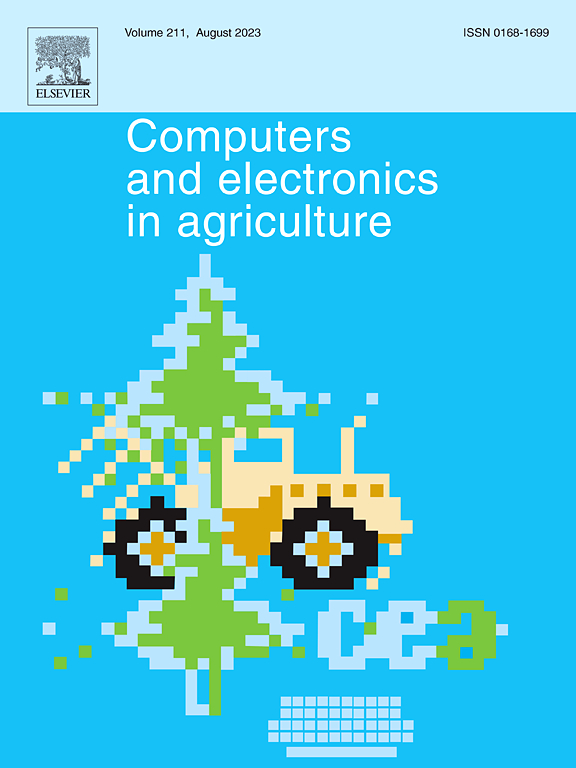基于单点云信息的活鸡个体体重预测方法
IF 8.9
1区 农林科学
Q1 AGRICULTURE, MULTIDISCIPLINARY
引用次数: 0
摘要
家禽表型测量研究是畜禽精准养殖的一个重要领域。随着农场动物生产标准的不断提高,准确获取家禽的各种表型参数显得尤为重要。体重是当今家禽生产中最重要的表型参数。它是监测生长和选择种畜的主要指标。传统上,家禽称重是用台秤进行的。然而,这些尺度的准确性受到鸡的运动的影响。为了解决这一挑战,本文提出了一种基于深度相机的单视点云数据预测活鸡体重的方法。该摄像机捕获了鸡背部的俯视图点云,并使用基于PointNet++的改进深度学习模型将该点云信息作为单个输入特征进行重量预测。在测试数据集上,权重预测的平均绝对误差为95 g(相对误差为6.66%),与观测权重的Pearson相关系数为0.8817。结果表明,该方法对预测活鸡体重有较好的效果。交叉验证试验表明,单品种数据集的体重预测结果与混合数据集(淮南山鸡MAE 92 g, MAPE 6.81%, Pearson相关系数0.7997)的预测结果基本一致;MAE 95 g, MAPE 7.35%, Pearson相关系数0.8265)。本研究表明,体重预测模型能够有效地捕捉不同品种之间的特征差异,预测结果准确。首次将点云数据与深度学习相结合进行活鸡体重预测,并对各种模型进行了对比分析,探讨了限制因素和改进策略。此外,单视角数据采集方法为商业家禽养殖场的实际应用提供了有价值的见解。本文章由计算机程序翻译,如有差异,请以英文原文为准。
Weight prediction method for individual live chickens based on single-view point cloud information
The research of poultry phenotypic measurement is an important area of Precision Livestock Farming (PLF). With continuously increasing standards for farm animal production, accurately obtaining various phenotypic parameters of poultry is particularly important. Body weight is today the most crucial phenotypic parameter for poultry production. It serves as a primary indicator for monitoring growth and selecting breeding stock. Traditionally, weighing poultry has been done using platform scales. However, the accuracy of these scales is affected by the chickens’ movements. To address this challenge, this paper proposes a method for predicting live chicken weight based on single-view point cloud data derived from a depth camera. This camera captures a top-view point cloud of the chickens’ back, and with an improved deep learning model based on PointNet++ for weight prediction using this point cloud information as a single input feature. On the test dataset, a mean absolute error of 95 g (6.66 % relative error) was found in the weight prediction, with the Pearson correlation coefficient with the observed weights being 0.8817. These results indicate that the proposed method performs well in predicting live chicken weight. Besides, the cross-validation experiment showed that the results of weight prediction, using single breed data set, were similar to those of a mixed data set (MAE 92 g, MAPE 6.81 % and Pearson correlation coefficient 0.7997 for Huainan partridge chicken; MAE 95 g, MAPE 7.35 % and Pearson correlation coefficient 0.8265 for Huxu chicken). This study demonstrates that the weight prediction model effectively captures feature differences among different breeds, yielding accurate results. As the first to combine point cloud data with deep learning for live chicken weight prediction, it conducts comparative analyses of various models and discusses limiting factors and improvement strategies. Additionally, the single-viewpoint data acquisition method offers valuable insights for practical applications in commercial poultry farms.
求助全文
通过发布文献求助,成功后即可免费获取论文全文。
去求助
来源期刊

Computers and Electronics in Agriculture
工程技术-计算机:跨学科应用
CiteScore
15.30
自引率
14.50%
发文量
800
审稿时长
62 days
期刊介绍:
Computers and Electronics in Agriculture provides international coverage of advancements in computer hardware, software, electronic instrumentation, and control systems applied to agricultural challenges. Encompassing agronomy, horticulture, forestry, aquaculture, and animal farming, the journal publishes original papers, reviews, and applications notes. It explores the use of computers and electronics in plant or animal agricultural production, covering topics like agricultural soils, water, pests, controlled environments, and waste. The scope extends to on-farm post-harvest operations and relevant technologies, including artificial intelligence, sensors, machine vision, robotics, networking, and simulation modeling. Its companion journal, Smart Agricultural Technology, continues the focus on smart applications in production agriculture.
 求助内容:
求助内容: 应助结果提醒方式:
应助结果提醒方式:


